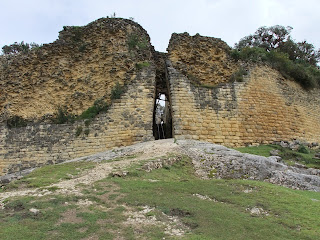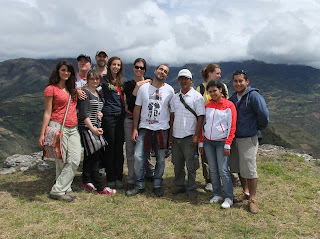Hello again,
Before beginning this entry I would just like to mention that when we returned to Bagua Grande we had received an e-mail from Conservation International regarding our application for the Primate Action Fund Grant... it stated that we had been awarded US$3,500 toward our project :D Fantastic news!
It was so strange thinking that this was going to be our final trip to the forest, especially when there was still quite a lot to do (census and vegetation data collection). We managed to get organised and set off much earlier than the previous trip. Unfortunately there were no mules available to help carry our equipment and food, so we rearranged our backpacks (loading the essentials) and left the everything else to be taken the following day.
The next morning we realised that we had not packed enough food to keep us going incase the mules did not arrive that day...but luckily later in the afternoon we saw a caravan of mules carrying bags approaching (we were so relieved).
After this, the days seemed to fly past - we were constantly working day and night collecting census data and it took two long days (12 hours) to complete the vegetation data collection on the trails. But we still had time to observe and admire the wildlife (various insects, frogs and birds...sadly no monkeys though) and beautiful scenery.
(big slug)
Although the majority of Cordillera Colan is protected forest, the buffer zone is not and we would occasionally hear chainsaws being used near our census points and sadly along one of our trails a large Ficus spp. tree was found (recently) cut down. All that was left was a stump, while the rest of the tree was further down the slope, it was not even being used for anything, which makes it even more sad because it is such a waste and in addition to this Nicola thought that it was a potential sleeping site tree for A. miconax.
(Cedar wood - this is frequently transported from the buffer zone)
After 7 days we had finally completed all of our data collection, Nicola had several sightings and presence data for the night monkeys (Aotus miconax) and even I managed to hear a few groups of yellow-tailed woolly monkeys (Oreonax flavicauda) at the census points, but sadly I did not see any. But it still did not feel as though we would not be returning.
The hike back seemed much easier this time and what once took us 6 hours only took 4 1/2! Sadly there was no jeep waiting for us, but luckily a taxi was driving by and despite our muddy appearance took us back to Bagua Grande.
We spent a few days in Bagua Grande recovering from our final trip and getting prepared for our return journey to La Esperanza. It is strange how quickly these 3 months have gone, but we have all had such an amazing experience.
(watching the sunset)
Sadly we had to say goodbye to Thiago who will be heading on to Ecuador, he has been a great help to us throughout the project and we will all miss him very much and wish him all the best with his project.
(Thiago)
Thanks for reading, hope you are all well wherever you are.

















































